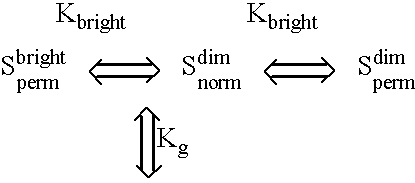Fluorescent lifetime assays for non-invasive quantification of analytes such as glucose
a lifetime assay and non-invasive technology, applied in the field of fluorescence based methods, can solve the problems of progressively debilitating, severe complications during the life of the diabetic individual, and diabetes costs the u.s. healthcare system about $100 billion annually
- Summary
- Abstract
- Description
- Claims
- Application Information
AI Technical Summary
Benefits of technology
Problems solved by technology
Method used
Image
Examples
example 1
[0298] Typical Instrumentation of the Invention
[0299] Instrumentation
[0300] Steady state fluorescence and fluorescence lifetime measurements are performed with the same instrument. A Fluorolog-Tau-3-21 (Jobin Yvon Horiba, formerly SPEX, Instruments S.A., Inc.), fluorescence spectrometer was used with a double monochrometer in the excitation path, a single monochrometer in the emission path, and a Pockels cell to modulate the excitation intensity for lifetime measurements as shown in FIG. 28.
[0301] The Xe lamp spectrum ranges from 250 nm to 900 nm. The double monochrometer has two 1200 groove / mm gratings blazed for optimal transmission at 330 nm. A reference photodiode detector, R, measures the intensity of the excitation light just before it enters the sample compartment. The sample compartment holds standard 1 cm.times.1 cm.times.3 cm cuvettes and is connected to the temperature bath to regulate the sample temperature. The emission monochrometer has one 1200 groove / mm grating blaze...
example 2
[0304] Typical Lifetime Measurements of the Invention
[0305] Lifetime Measurements
[0306] Measurements of fluorescence lifetimes were done in the frequency domain. This is also known as the phase-modulation technique. Instead of using a short pulse of light to excite fluorescence, as is commonly done, the sample is excited by a continuous beam of light with sinusoidally modulated intensity. The resultant fluorescence is also sinusoidally modulated, but reduced in intensity and with a phase lagging that of the incident light. This phase lag, as well as the ratio of demodulation, is a measure of the fluorescence lifetime. FIG. 29 shows the relationship between sinusoidally modulated excitation light of form
I(t)=A+B sin(.omega.t)
[0307] where A and B are constants describing the DC offset and modulation amplitude of the light, and .omega.=2.pi.f where f is the frequency of modulation in Hz and the resulting fluorescence light is of the form
F(t)=a+b sin(.omega.t-.phi.)
[0308] where a and b ...
example 3
[0311] Typical Sample Preparation of the Invention
[0312] Sample Preparation
[0313] All of the fluorescent sensor molecule were synthesized as described above. Stock solutions of the fluorescent sensor molecules were prepared in MeOH. The MeOH (99.9%) was obtained from Aldrich. Buffer solutions were made for pH 2 through 13. This phosphate buffered saline (PBS) which includes 0.138 M NaCl and 0.0027 M KCl, was prepared according to directions at 0.01 M and was measured to have a pH value of 7.4 at 25.degree. C. The D-(+)-Glucose (99.5%) was obtained from Sigma (EEC# 50-99-7) and was prepared at concentrations of 300 g / L in water.
[0314] Samples for all fluorescence measurements were made in standard 3 mL quartz cuvettes from either Stama Cells or NSG Precision Cells, Inc. Fluorescent sensor molecule concentrations were kept in the micromolar range to avoid excimer formation and self-absorption influencing the lifetime measurements.
[0315] A reference fluorophore with a known lifetime is...
PUM
| Property | Measurement | Unit |
|---|---|---|
| pKa | aaaaa | aaaaa |
| pKa | aaaaa | aaaaa |
| excitation wavelength | aaaaa | aaaaa |
Abstract
Description
Claims
Application Information
 Login to View More
Login to View More - R&D
- Intellectual Property
- Life Sciences
- Materials
- Tech Scout
- Unparalleled Data Quality
- Higher Quality Content
- 60% Fewer Hallucinations
Browse by: Latest US Patents, China's latest patents, Technical Efficacy Thesaurus, Application Domain, Technology Topic, Popular Technical Reports.
© 2025 PatSnap. All rights reserved.Legal|Privacy policy|Modern Slavery Act Transparency Statement|Sitemap|About US| Contact US: help@patsnap.com



